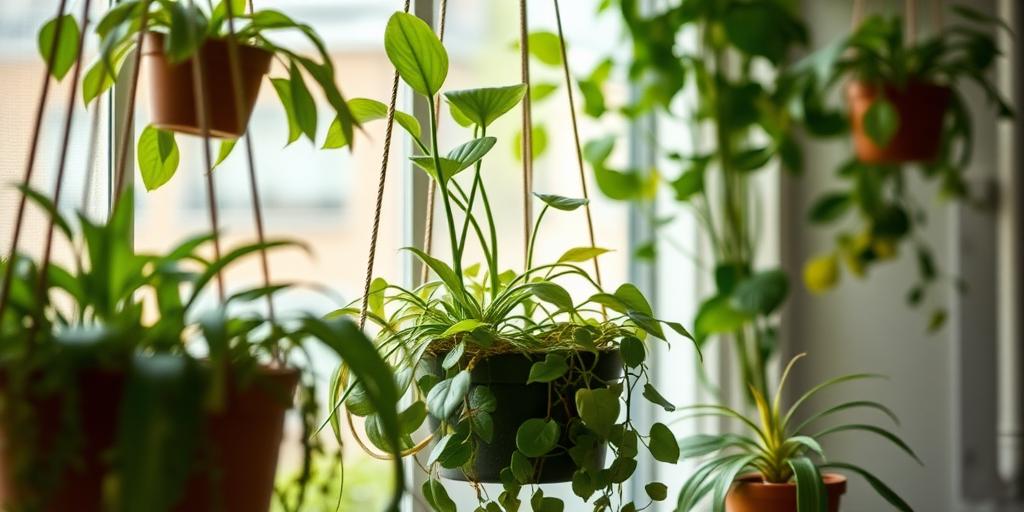
How to Water Your Low Light Hanging Plants: A Complete Guide
Learn the best practices for watering low light hanging plants to keep them thriving! This guide covers watering frequency, signs of overwatering, and expert tips for healthy growth.
Introduction
Did you know that overwatering is the #1 killer of indoor plants, especially those in low light? Hanging plants add beauty to any space, but their watering needs can be tricky—too much or too little, and they’ll suffer. Whether you’re a new plant parent or a seasoned green thumb, this guide will help you master the art of watering low light hanging plants for lush, vibrant foliage. Let’s dive in!
Understanding Low Light Hanging Plants’ Watering Needs
What Makes Low Light Plants Different from Other Houseplants?
Low light hanging plants have adapted to thrive in dimmer conditions, which means they generally grow slower and use less water than sun-loving plants. Their leaves are often broader and thinner, allowing them to capture as much light as possible. Because they’re not exposed to intense sunlight, their soil stays moist longer, making overwatering a bigger risk than underwatering.
How Light Levels Affect Watering Frequency
The less light a plant gets, the slower its photosynthesis and water uptake. A pothos in a bright bathroom may need weekly watering, while the same plant in a dim corner might only need water every 10–14 days. Always adjust watering based on your specific environment—don’t rely on a fixed schedule.
Common Types of Low Light Hanging Plants
Some popular low light hanging plants include:
-
Pothos (Epipremnum aureum): Hardy and forgiving, with trailing vines.
-
Spider Plant (Chlorophytum comosum): Produces baby offshoots and thrives in indirect light.
-
Philodendron (Heartleaf or Brasil): Adaptable and fast-growing in low to moderate light.
-
Peperomia (e.g., Peperomia scandens): Compact with succulent-like leaves that store water.
Each has slightly different needs, but all prefer drying out slightly between waterings.
Signs Your Hanging Plant Needs Water
Dry, Crispy Leaves vs. Yellow, Drooping Foliage
-
Underwatered plants often have dry, brittle leaves that may curl or brown at the edges.
-
Overwatered plants tend to have yellowing leaves that feel soft or mushy, and the stems may droop.
Checking Soil Moisture: Finger Test vs. Moisture Meters
-
Finger test: Stick your finger 1–2 inches into the soil. If it’s dry, it’s time to water.
-
Moisture meter: A more precise tool, especially for deeper pots. Aim for a reading in the “dry” to “moist” range for most low light plants.
Weight of the Pot as an Indicator
Lift the pot after watering to feel its weight. As the soil dries, the pot becomes noticeably lighter—a handy trick for hanging plants that are hard to reach.
How Often to Water Low Light Hanging Plants
General Watering Schedule Based on Plant Type
-
Pothos/Philodendron: Every 1–2 weeks.
-
Spider Plant: Every 7–10 days.
-
Peperomia: Every 10–14 days (they store water in their leaves).
These are rough estimates—always check the soil first!
Seasonal Adjustments (Winter vs. Summer Care)
-
Summer: Plants may need more frequent watering due to warmer temperatures and growth spurts.
-
Winter: Reduce watering by 25–50% as growth slows and evaporation decreases.
Factors That Influence Watering Frequency
-
Pot size: Small pots dry out faster than large ones.
-
Humidity: High humidity = less frequent watering.
-
Air circulation: Good airflow helps soil dry evenly; stagnant air can lead to mold or rot.
Best Watering Techniques for Healthy Growth
Bottom Watering vs. Top Watering: Pros and Cons
-
Bottom watering: Place the pot in a tray of water and let the soil soak it up. Prevents overwatering and encourages deep root growth, but salts can build up over time.
-
Top watering: Pour water evenly over the soil until it drains out. Flushes out salts but can compact soil if done too forcefully.
Avoiding Waterlogged Soil with Proper Drainage
Always use pots with drainage holes. If water sits in the saucer, empty it after 30 minutes to prevent root rot. For decorative pots without holes, add a layer of pebbles at the bottom or use a nursery pot inside.
Using Room-Temperature Water to Prevent Shock
Cold water can shock roots, especially in tropical plants. Let tap water sit overnight to dissipate chlorine, or use filtered water if your plant is sensitive.
Common Watering Mistakes to Avoid
Overwatering: Root Rot and How to Prevent It
Root rot is a silent killer—mushy, black roots and a foul smell are telltale signs. To avoid it:
-
Water only when the top inch of soil is dry.
-
Ensure pots have drainage.
-
Use well-draining soil (more on that below).
Underwatering: Signs and Recovery Tips
If your plant is severely dry:
-
Soak the pot in a water bath for 30 minutes to rehydrate evenly.
-
Trim crispy leaves to redirect energy to healthy growth.
Why Misting Isn’t Always the Solution
Misting can raise humidity slightly, but it doesn’t replace watering and can promote fungal growth on leaves. For humidity-loving plants like philodendrons, use a pebble tray or humidifier instead.
Choosing the Right Soil and Pots
Best Soil Mixes for Low Light Hanging Plants
-
Well-draining mix: Combine potting soil with perlite or orchid bark (great for pothos and philodendrons).
-
Moisture-retentive mix: Add coco coir or sphagnum moss for plants like ferns that prefer consistently damp (not soggy) soil.
Ideal Pot Materials
-
Terracotta: Breathable, helps soil dry faster—good for overwaterers.
-
Ceramic/Glazed: Retains moisture longer; best for plants that like even moisture.
-
Plastic: Lightweight and cheap, but holds water—adjust watering accordingly.
Importance of Drainage Holes and Alternatives
No drainage holes? Try:
-
A layer of activated charcoal at the bottom to absorb excess moisture.
-
A cache pot system (nursery pot inside a decorative one) for easy removal and drainage checks.
Troubleshooting Watering Problems
Reviving an Overwatered or Underwatered Plant
-
Overwatered: Remove from soil, trim rotten roots, repot in fresh mix, and hold off watering until the plant recovers.
-
Underwatered: Soak the pot, trim dead foliage, and place in bright, indirect light to encourage recovery.
Dealing with Pests Caused by Improper Watering
Fungus gnats love wet soil—let the top layer dry out and use sticky traps. Spider mites thrive in dry conditions—increase humidity and rinse leaves regularly.
When to Repot for Better Water Management
Repot if:
-
Roots are circling the pot or poking out of drainage holes.
-
Soil dries out too fast or stays soggy for days.
-
The plant looks unhealthy despite proper watering (could be compacted or depleted soil).
A well-timed repot can reset your plant’s water balance and give it room to grow.
Conclusion
Watering low light hanging plants doesn’t have to be a guessing game! By understanding their unique needs, recognizing early warning signs, and using the right techniques, you can keep your plants healthy and thriving. Start implementing these tips today, and watch your greenery flourish—even in the shadiest corners of your home.
